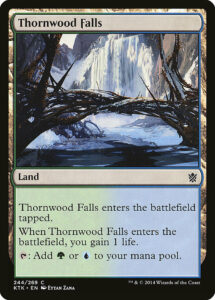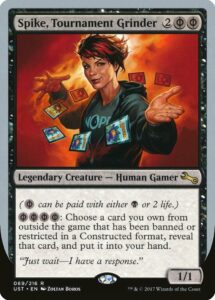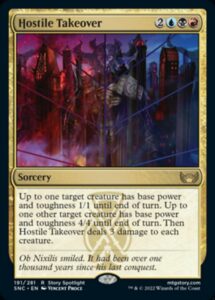Streets of New Capenna has been available for over a week now, so I’ve had the chance to draft it over a dozen times in person and digitally. I had plenty of guesses about how the format would play out, and I mostly still hold by them. And, well—I’m not loving the format. I don’t dislike it, but I can’t see it holding my interest for the 4+ months until Dominaria United releases in September.
And yet, it has hallmarks of formats I deeply love, making it feel like I should love it. So, today, I’m going to try to get to the bottom of what makes Streets of New Capenna tick, and why it’s not vibing with me.

Fixing = Fun
I love having the ability to be greedy with my manabases, so I tend to prefer formats with large amounts of fixing. I also recognize that it’s dangerous for a format to support too much greed—there needs to be a streamlined fun police to prevent the format from devolving into a homogenous good-stuff soup.
I think Streets of New Capenna does a fantastic job of threading this needle. There is a preponderance of fixing between the common fetch lands, dual lands, pseudo-Haunt creatures, and treasure producers, making it easy to stretch your manabase to play 3-5 colors. Indeed, my last several undefeated decks on Magic Arena were all five-color decks. At the same time, there are strong two-color streamlined aggressive decks that can prey on greedy drafters. And it can be harder to stabilize with how small most creatures are and how many cards rely on synergy rather than raw power to function. All that is a recipe for well-functioning environment full of fixing and is something I truly appreciate about Streets of New Capenna.

Fun mechanics in principle…
In practice, I’m not loving how Streets of New Capenna’s mechanics are playing. I’ve already talked about how Casualty, Connive, and Blitz are Spike-first mechanics. They are skill-intensive, rewarding players for properly evaluating the board state and the value of resources now versus in the future.
This should be awesome for a fairly competitive player like me, since it gives me lots of decisions to make and plenty of opportunities to outplay my opponents. In practice, I find it tiring. There are so. many. choices. Moreover, these choices are not in isolation: there’s plenty else competing for your brain’s attention. Because of the common fetchlands, you need to be constantly aware of exactly how many and which basic lands are in your deck as you sequence your plays. Because of submechanics like the blue-black graveyard threshold of five different mana values, you really want to be constantly aware of both players’ graveyards—and a threshold of five is one above what human brains are easily able to calculate on the fly.
You need to execute Alliance triggers correctly, follow proper timing rules on Blitz (which differ depending on whether the creatures is sacrificed at end of turn or dies earlier), be aware of which creatures are Citizens, and know the combat rules around shield counters (double-blocking is awful). In addition, there are individual card themes like Vampire Scrivener, Ledger Shredder, Freelance Muscle, and Scuttling Butler that suddenly make a very specific thing constantly relevant.
The sum total of all of this is exhaustion. Each game involves so many choices, starting from the very first turn, that it’s hard to evaluate which are correct. It’s hard to learn from my mistakes when it’s hard to tell which choices did and didn’t work out by virtue of the sheer number I’m making. Now, you might say that this is a good thing, that it’s a sign of a deep format which plenty to chew on. That it’s indicative of how great a job design did by creating all these inter-faction synergies and micro-themes.
Perhaps you’re right—but as someone who has been playing Limited competitive nonstop for over a decade, if it’s this exhausting for me, imagine what it’s like for someone who’s only been playing for a year or two? Or if this is their first Limited format? And moreover, being challenging can be fun, but overwhelming?

Invalidation
Perhaps my subtlest issue with Streets of New Capenna is that the most important elements aren’t highlighted. So many games feel like they’re decided by the set’s inclusion of four powerful rare sweepers: Corpse Explosion, Depopulate, Incandescent Aria, and especially Hostile Takeover. A Disciplined Duelist can be an unbeatable threat against Cabaretti decks and facile to answer for blue-black decks, leading to an unbalanced rock-paper-scissors. The most powerful common creatures are generically good (but can be improved further with synergy): Inspiring Overseer, Corrupt Court Official, Girder Goons, Mayhem Patrol, Jewel Thief, Celestial Regulator, and Body Dropper.
The point of these three disparate opinions is that absolutely none of them involve playing the tricolor factions and engaging heavily with their mechanics—what the format is ostensibly all about. I’m fairly convinced that the best things to do are either be a two-color deck with at most a light splash (ideally WU, UB, or BR) or be a very greedy deck. There simply aren’t enough rewards for committing hard to Casualty or Alliance—the cards bearing the mechanics and the common tricolor cards simply aren’t strong enough.
There is so much more payoff for being aggressive and lightly engaging with the mechanics, or being greedy and using a little bit of all of them. The root cause comes from a very good place—providing bridges across mechanics, giving players obviously good commons and subthemes to engage with, and creating exciting rares for Constructed—but the end result undermines the stated purpose of the format.
At the end of the day, Streets of New Capenna reminds me a lot of Kaldheim and Strixhaven. Both formats had really sweet stuff to do, but were also full of trap archetypes like WU Foretell, WB Second Spell-matters, and the entire Lorehold college. Both ended up featuring greedy decks (mostly green-based in Kaldheim and blue-based in Strixhaven) versus specific aggressive decks (monowhite in Kaldheim and WB in Strixhaven).
On paper, Streets of New Capenna should be more balanced, given that it seems like there are multiple flavors of aggressive decks and functional, exciting mechanics. In practice, I feel like none of the mechanics have as much depth as did Learn, Magecraft, and Snow, and the best decks don’t leverage them enough. I recognize that these are my own biases and preferences, but I worry that Streets of New Capenna fails in its implicit, essential promise that it actually is about playing tricolor factions. And if I’m right, I feel like I’ve mostly seen what the format has to offer: lots of choices, lots of optional textures, and a lot of players trying and failing to win by following the set’s directions.
So, while I’ve been having fun with Streets of New Capenna, I feel like I’m going to burn out extremely fast. And that’s already with me playing less Arena after the Best of 3 Limited economy was just made substantially worse.
Zachary Barash is a New York City-based game designer and the last commissioner of Team Draft League. He designs for Kingdom Death: Monster, has a Game Design MFA from the NYU Game Center, and does freelance game design. When the stars align, he streams Magic (but the stars align way less often than he’d like).

